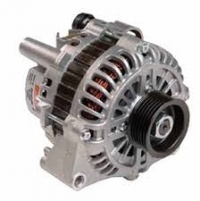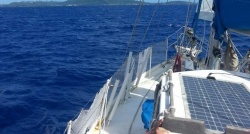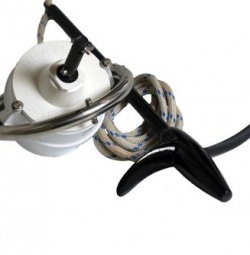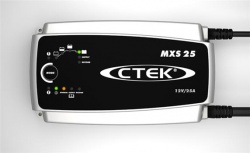Power Generation
From CruisersWiki
Power Generation
Electrical power generation on a sailing yacht is used for two purposes:
- Charging the batteries which are used to power the on-board equipment (lighting, autopilot, refrigerator, freezer, etc).
- Providing AC current to power on board AC systems such as refrigeration, air conditioning, water makers, power tools, etc.
|
Battery Charging
Charging a battery is much like pumping air into a tyre. The voltage in the battery equates to the air pressure in the tyre, and the voltage at the charging source equates to the air pressure in the pump. When the voltage in the battery is low, a high voltage at the charging source causes a significant amount of charge, or current measured in Amps, to flow into the battery. As the battery voltage increases (like increasing the air pressure in the tyre), the amount of current flowing into the battery reduces.
This continues until the difference between the voltage in the charging source and the voltage in the battery is too small to allow any more current to flow into the battery. The only way to continue charging the battery at that point is to increase the voltage at the charging source.
AC Power Generation
To run AC powered equipment on board requires either a genset or an inverter, generating the appropriate amount of power at 110V or 240V AC (the most commonly used voltages).
More info needed ...
Load Analysis
Estimating total load ...
Determining battery capacity ...
Determining optimum charge capacity ...
Engine Alternators
The theory behind an engine alternator is that a current flowing in a wire generates a magnetic field around the wire, and conversely, a wire moving inside a magnetic field has a current generated inside it.
An engine alternator works by having a rotating electromagnet (rotor) spun by a belt driven by the engine. The rotor creates a magnetic field, around which are placed some fixed outer windings made of wire (stator). The electromagnet in the rotor is powered by a small field current which creates a rotating magnetic field. This creates an alternating current in the stator by the magnetic field. A solid state rectifier mounted on the outer case of the alternator converts the AC into DC and a charge controller (or regulator) converts that DC into a current useful for charging the battery.
Regulators
Alternators are fitted with regulators that adjust the output voltage of the alternator by adjusting the input voltage to the field coil in the alternator rotor. If a higher voltage is applied to the rotor then the stator will produce a higher output voltage.
Because an inbuilt alternator reduces the output voltage of the alternator, as the battery becomes more fully charged the regulator will quickly reduce the output of the alternator to a fraction of the alternator's capacity, and the motor will be spinning for a long time to recharge the battery. This problem can be overcome by fitting an external regulator to the existing alternator. These are stand-alone electronic units that can drive the alternator as hard as possible to fully charge house batteries in the shortest possible time.
Companies such as http://www.amplepower.com/ Ample Power], Mastervolt and Sterling produce external alternator regulators, these usually require some form of modification to the existing alternator such as unscrewing the existing standard alternator regulator and brush holder assembly, which can be done by an auto electrician.
Generators (Gensets)
Diesel Gensets
Petrol Generators
Solar Panels
Typically when we say "solar panel" on a boat we mean a photovoltaic module (PV module). A PV module is a packaged, connected assembly of solar cells in an array which can provide an output voltage (typically in the 12 - 24 volt range).
The main types of PV modules in use on boats include:
- Polycrystalline modules packaged under glass
- Monocrystalline modules packaged under glass
- Thin film modules on a steel or flexible substrate, without a glass coating
The type of solar panel you want may depend on mounting considerations. For maximum efficiency per dollar spent, monocrystalline panels are the best choice. However thin film / flat panel type PV modules have their advantages especially in situations where they may need to be walked on.
Shade
Shade is the enemy of power generation with solar panels -- this should go without saying, however the effect of shade on a solar panel is more than you might think.
For example a typical solar panel rated at 12V nominal / 100W peak might produce 80W on a typical sunny day in a subtropical region at ideal temperatures, but shading 25% of the panel might reduce that not to 60W, but perhaps as low as 10W or 20W.
This means that mounting considerations are important when mounting solar panels. Mount them as high as possible or at least where there is the smallest possible amount of shade during the course of the day.
Solar panels don't work at night. Some people seem to forget this. A 100W rated solar panel will not generate as much power over 24 hours as will a 100W tow generator with the yacht cruising at 6 knots.
MPPT vs PWM Controllers
See Charge Controllers.
The choice of an MPPT vs PWM controller is much more important with solar panels than with any other type of power generation system.
Typically the maximum output of a solar panel will occur at a particular voltage, and that voltage will vary depending on sun conditions, ambient temperature, etc.
A PWM controller will pull the voltage of the panel down to a certain level, equivalent to the voltage required to charge the batteries. Typically this will be somewhere between 12.5 and 13.8 volts, whereas the maximum power point of a solar panel nominally rated at 12V may be closer to 15V or even 17V. An MPPT controller will allow the panel to output at its maximum power point and step the voltage so generated down to the voltage of the battery.
Using MPPT controllers it is also possible to run multiple solar panels in series. For example, 4 x 12V panels could be run together in series to produce an output voltage around 48 - 60 volts total, and the MPPT controller will step this down to the voltage required to charge the battery. Note that this requires a lot more current handling capacity inside the controller -- larger and more expensive MPPT controllers will do this better than smaller and cheaper controllers.
Wind Generators
Tow Generators
There are few manufacturers of dedicated tow generators (water turbines) around, which is a pity because a properly set up tow generator can produce a lot of power on a passage -- frequently more than a wind generator.
The main ones are:
- Aquair 100 by Ampair. This is a generator that can be rigged either way -- as a wind generator or as a tow generator. The unit can have a water turbine attached on a long line in tow generator mode, or can have a tail and blades added to operate as a wind turbine. The unit is rated at 100W which means around 8A at 12V. Delatbabel -- I successfully used one of these for 5000+ miles of sailing in the South Pacific, including deep in the southern ocean where there was little or no power coming in via the solar panels. I got a steady 4-6A out of it at cruising speed.
- Ferris Waterpower 200 from the USA is sold as a tow generator but can also be converted to a wind generator. This one claims to generate 200Ah per day which means approximately 8A at 12V, also approximately 100W.
- Eclectic Energy in the UK make 2 types of tow generator, one being the DuoGen 3 which is a convertible wind/water generator and the other being the Sail-Gen which uses the same components but is a dedicated tow generator.
Charge Controllers
MPPT Controllers
See MPPT on wikipedia.
PWM Controllers
AC Battery Chargers
A battery charger (typically running from 110V or 240V AC) is used to charge house and/or engine batteries from an AC power source. Typically this is used to charge on board house batteries from shore power systems while docked at a marina berth, however it can also be used as a more efficient means of charging house batteries from small gensets incapable of producing large DC currents.
e.g. a Honda 1000i genset can typically output 8A at 12V but can also output 1000W at 240V, which is around 4A. A battery charger providing 40A to the house batteries can usually run fine from the AC output of such a generator, which means that the same amount of generator fuel is used to provide 40A of battery charging via AC as would be used to provide 8A of charging via DC.
Battery chargers vary in size and capacity from 10A or less up to 100A or more. Usually a battery charger should be sized to approximately 10% of the total house battery capacity, so a 400A battery bank should be equipped with a 40A charger. A smaller charger will run OK but will take longer to charge the batteries, while a larger charger will not be able to run at full capacity because of the inability of typical deep cycle batteries to absorb charge at a faster rate.
Battery chargers are becoming more common and cheaper these days with companies like CTEK and others producing them at commodity prices. Auto shops and marine chandlers will usually have a range of different capacity chargers.
One reasonably recent introduction is the combined charger/inverter. This combines the functions of an AC battery charger with an inverter, having one AC input, one AC output, and an input/output for the house battery bank. Companies like Magnum Energy, Victron Energy and Mastervolt produce a range of inverter/chargers with different input and output capacities.
Forum Discussions
List links to discussion threads on partnering forums. (see link for requirements)
- Solar Panels - Which Ones? on Cruiser Log.
References
Publications, etc.
External Links
Also See
Personal Notes
- Delatbabel -- I have 4 solar panels aboard my boat:
- 2 x flat 80W panels, "Lensun" brand, on top of the doghouse roof. I purchased these via eBay. These run in parallel into a 15A MPPT controller.
- 1 x monocrystalline panel, 75W Kyocera, This runs in parallel with a wind generator and a tow generator and goes into a 15A MPPT controller.
- 1 x polycrystalline panel, 200W Solraiser. This runs into a into a "Morningstar" brand PWM controller.
- The panels generally give pretty good output. I'm impressed by the Lensun panels, I walk on these a lot because I need to get up on the doghouse roof to set and unset the main sail, and they still produce quite a lot of power. I'm less happy with the Solraiser panel, the peak output from it appears to be about 4A and it is a lower voltage panel (peak output at 12V compared to say 15V for some other panels) meaning that it's less easy to run its full output via an MPPT controller into a 12V system. 2 of these in series might have been a better option. It seems to do much better running into a PWM controller but really only gets up to full power when the battery voltage is quite low.
- In addition to the above I have a 25A battery charger, a 1000W petrol generator, a 100W wind generator and a 100W tow generator. Despite this I occasionally need to run the engine while on passage (I don't run the petrol generator on passage because there is nowhere to safely put it, while at anchor I have it on deck), so I'm considering an external alternator regulator to reduce the amount of engine run time.
|
|---|
|
Names: Delatbabel |
| |
|---|
| | HOMEPAGE | Wiki Contents | Power Generation |
.



